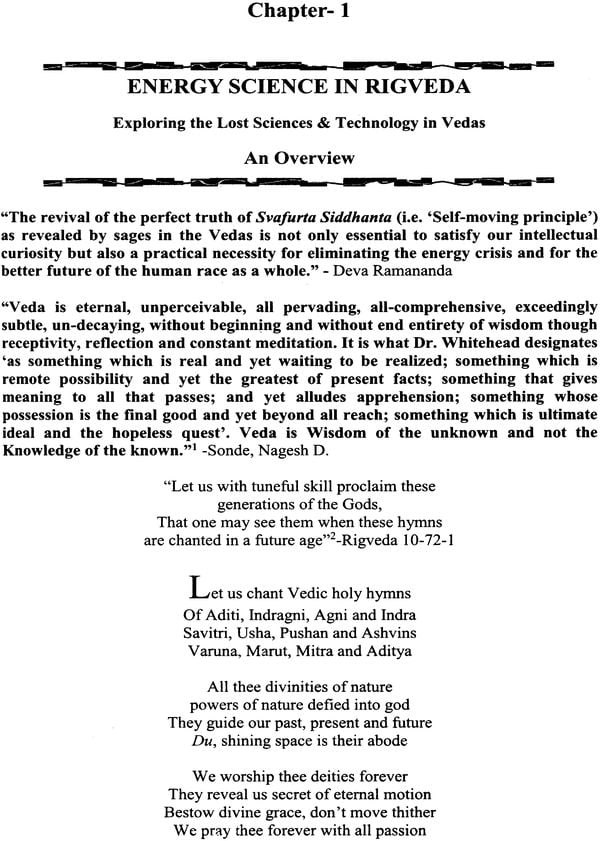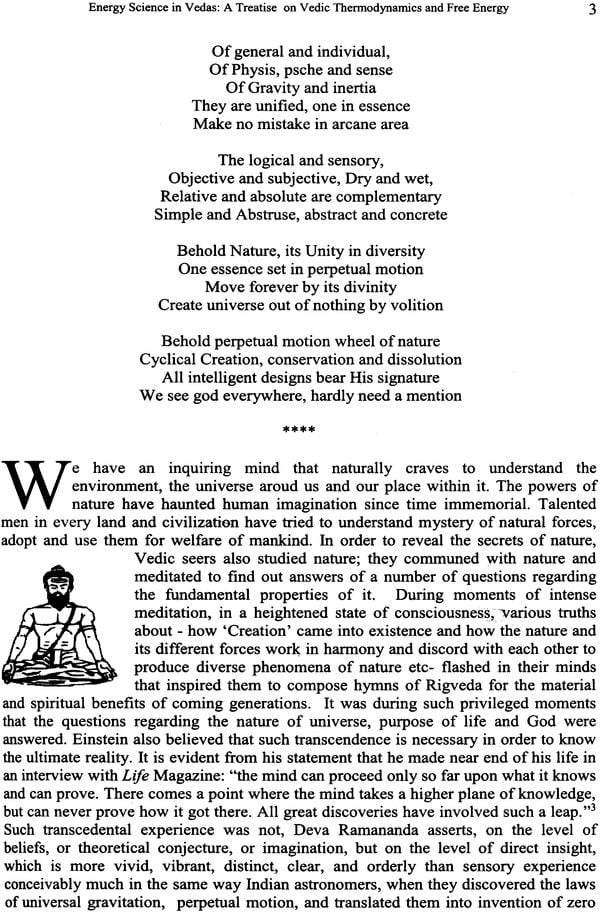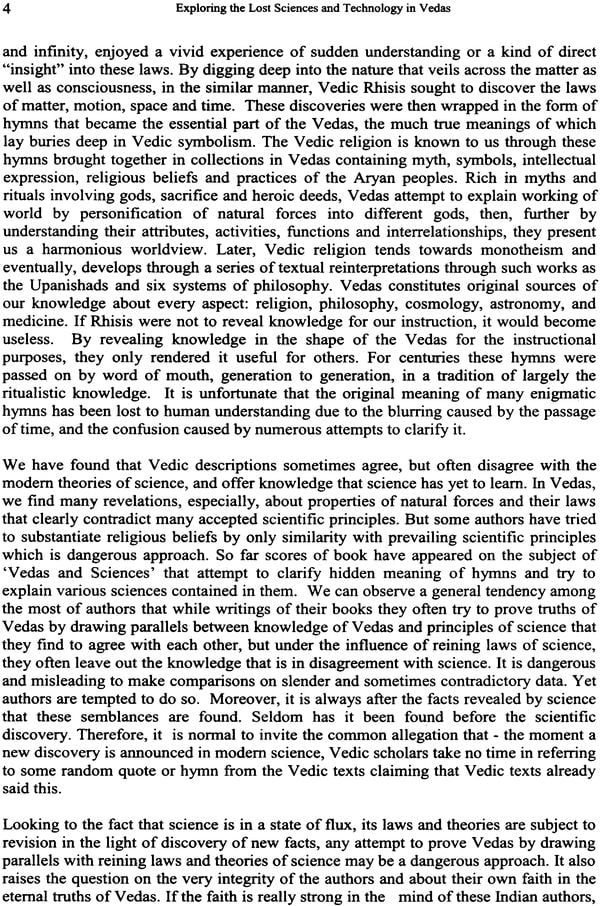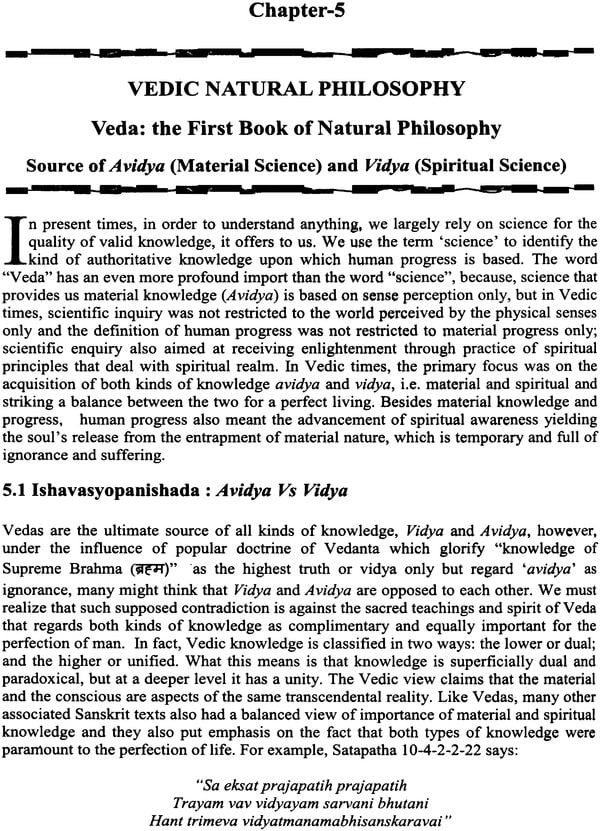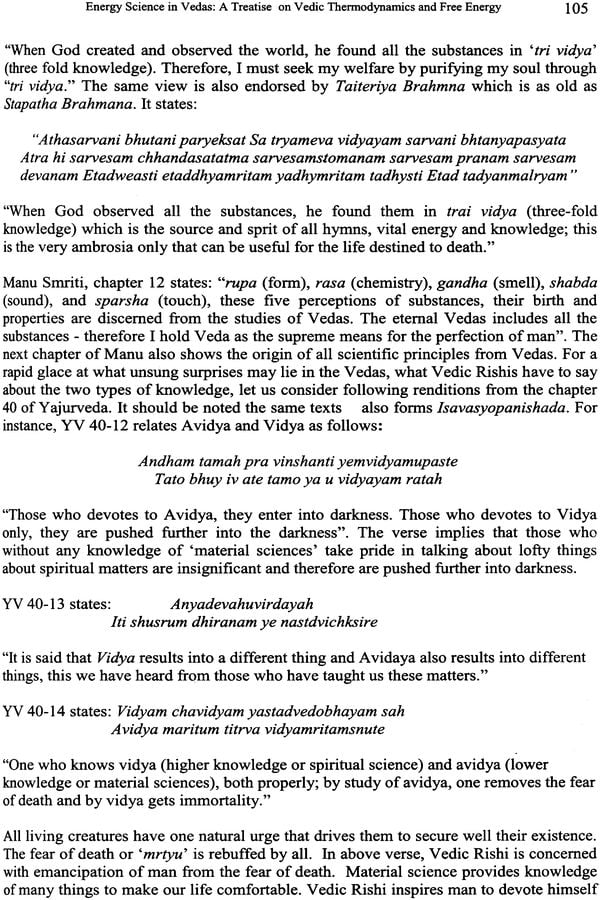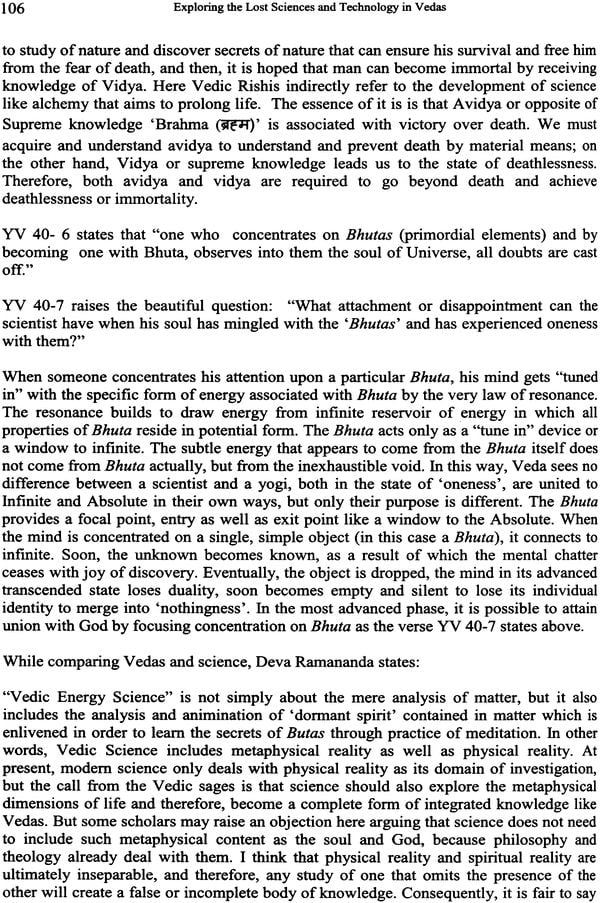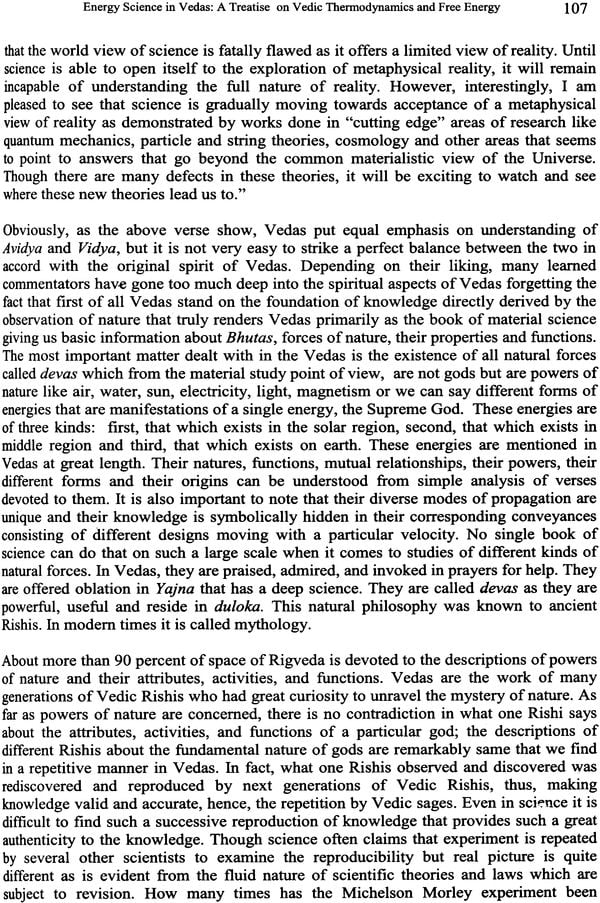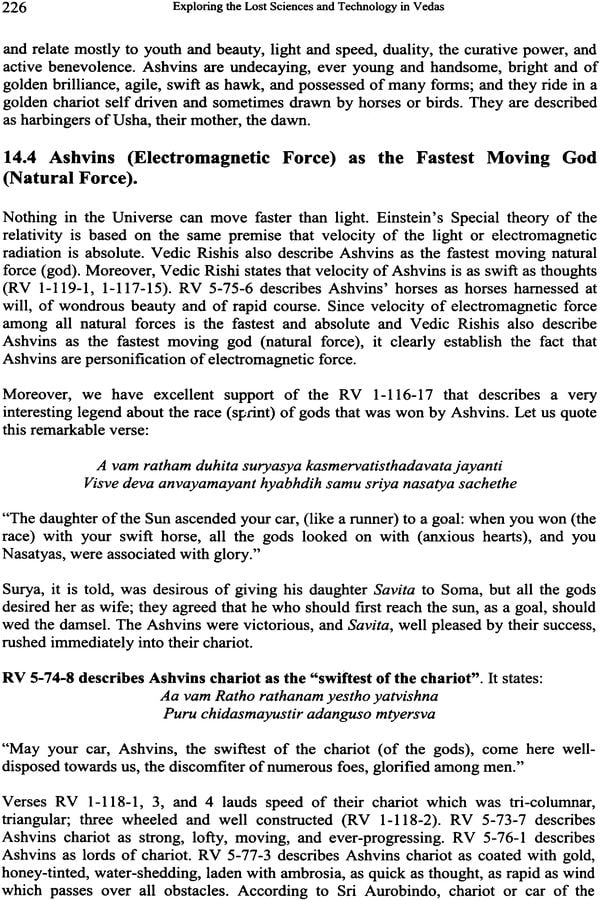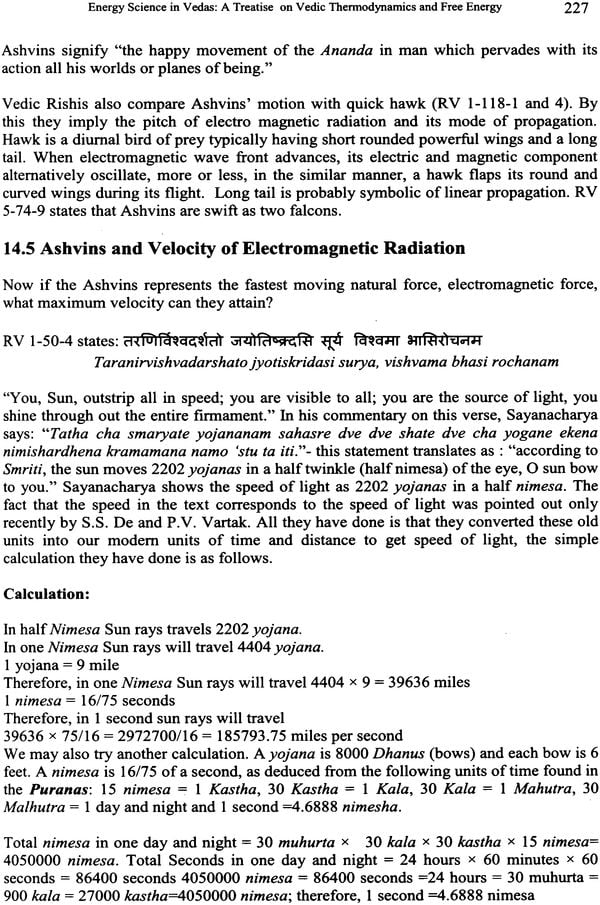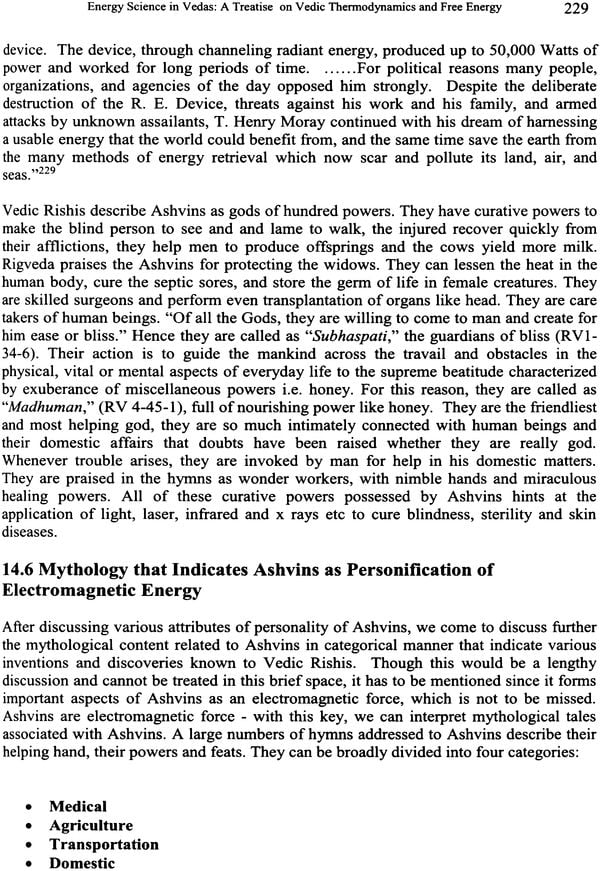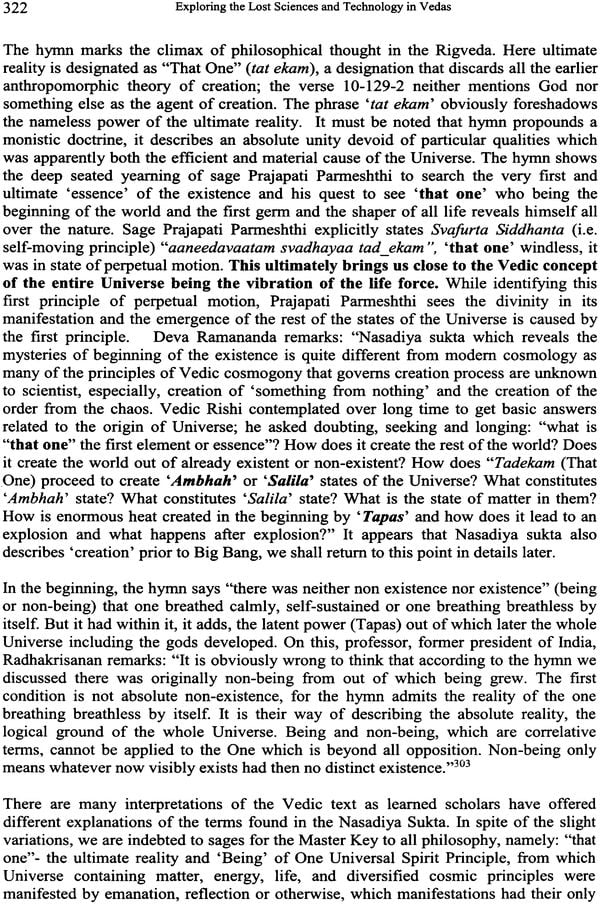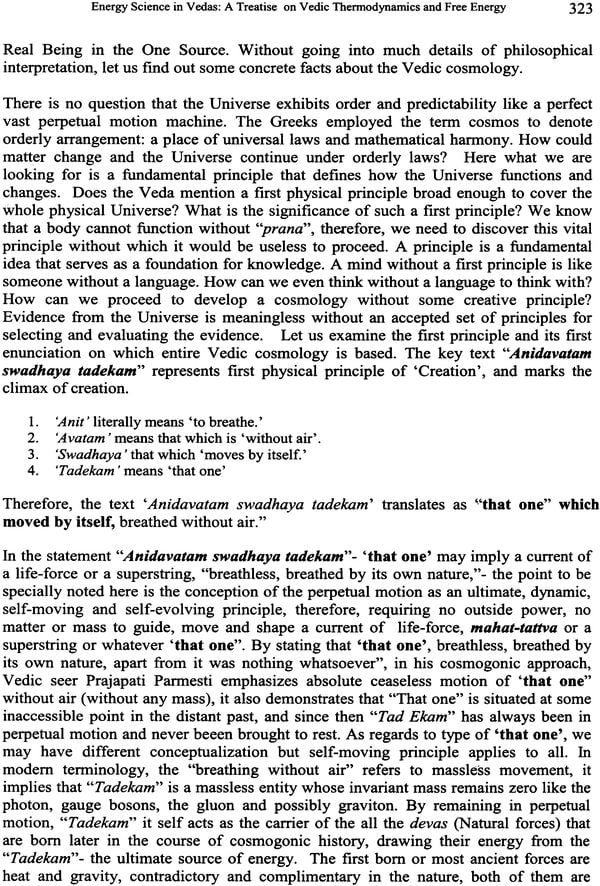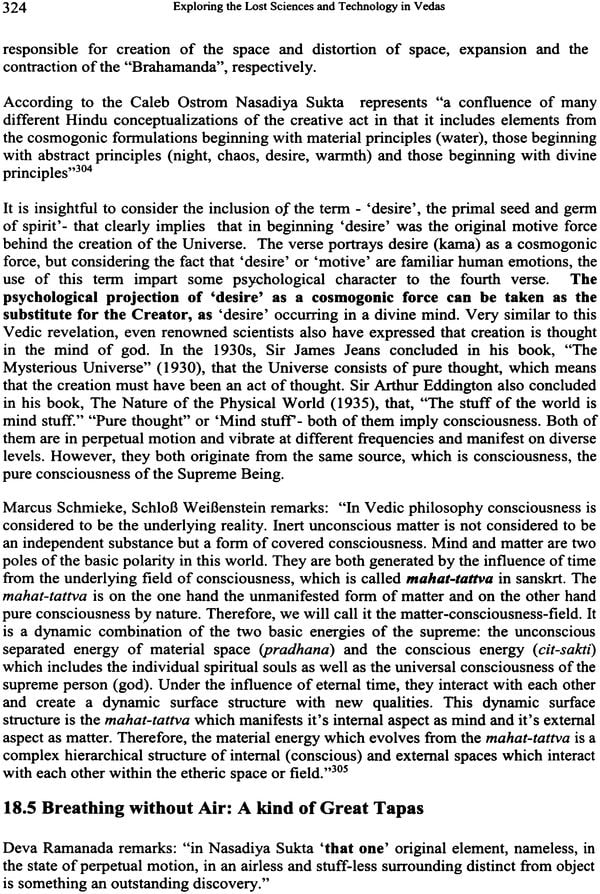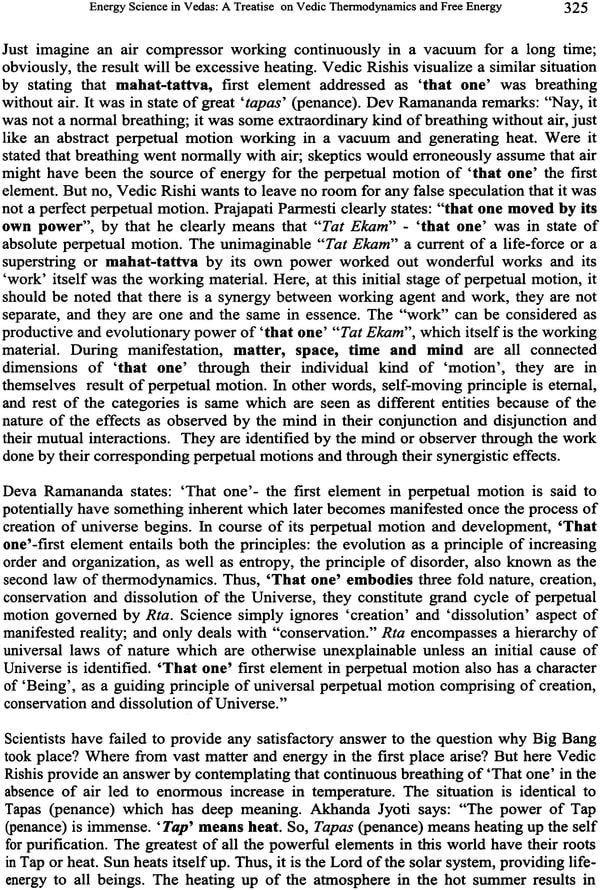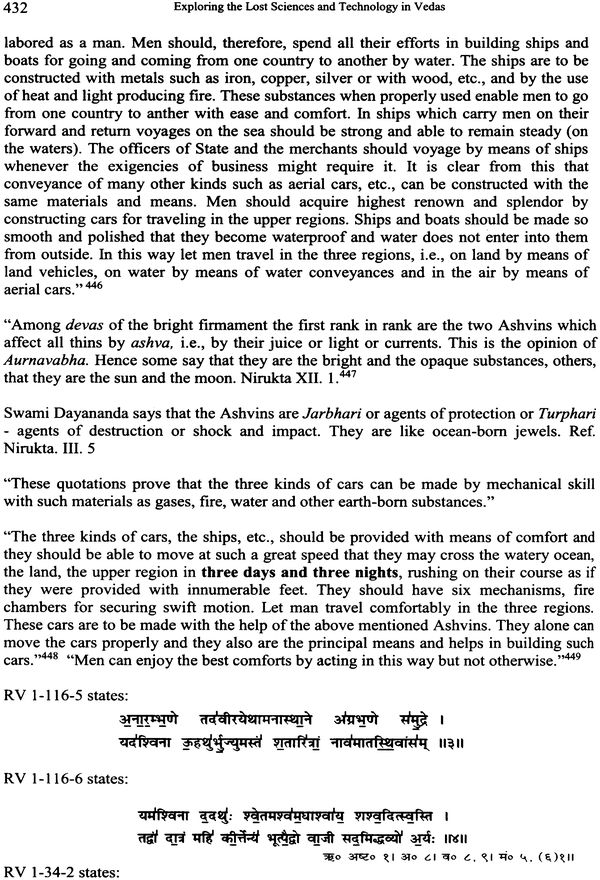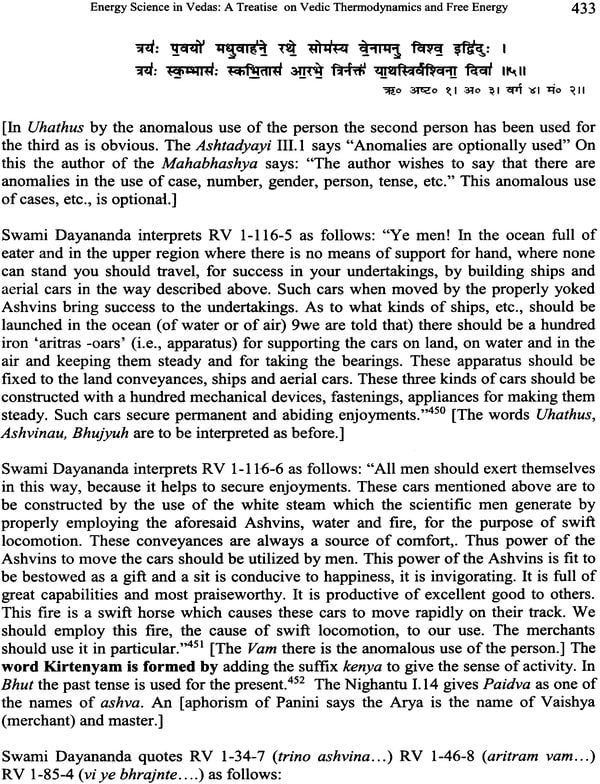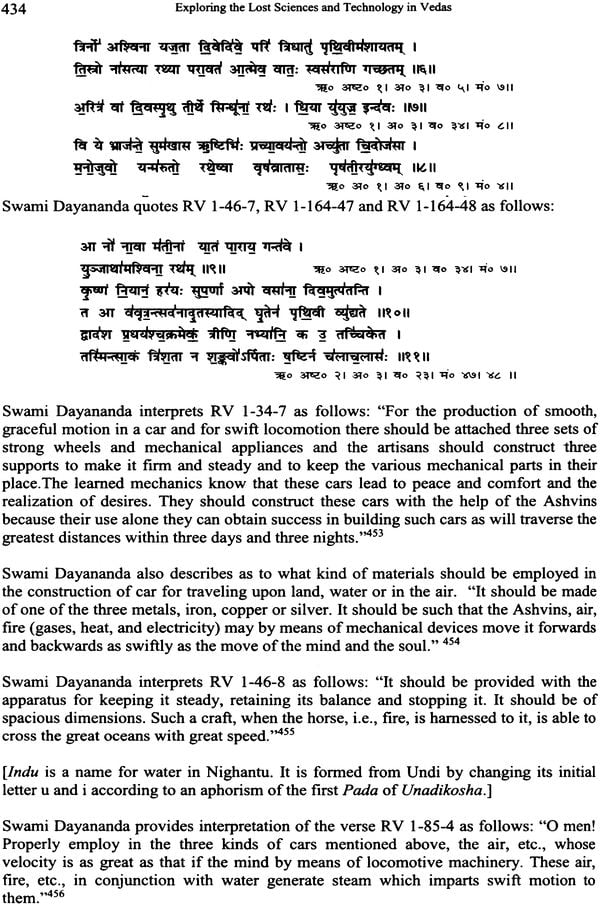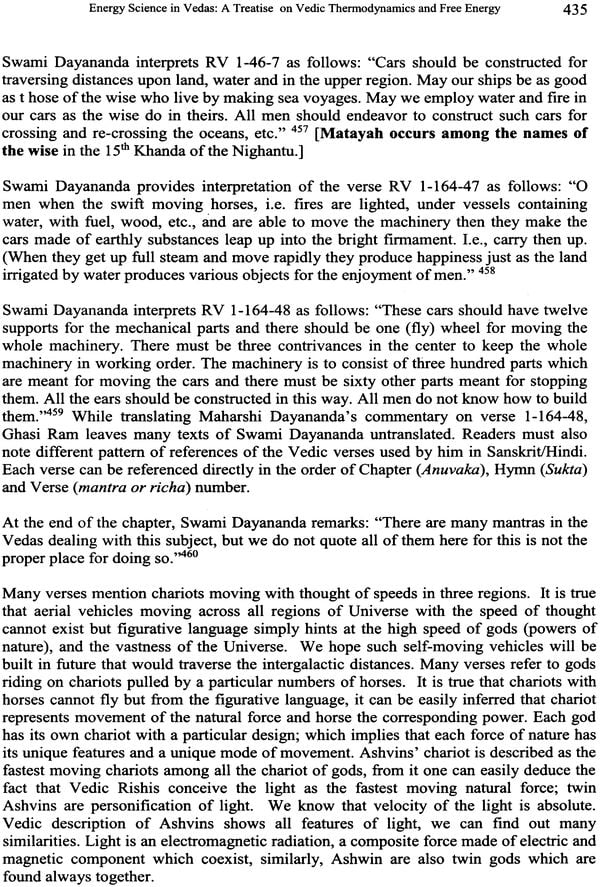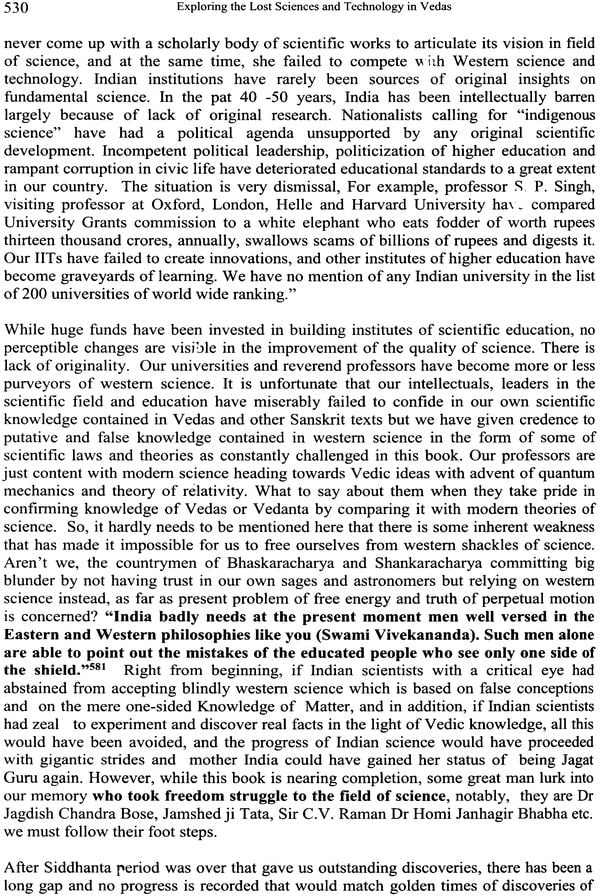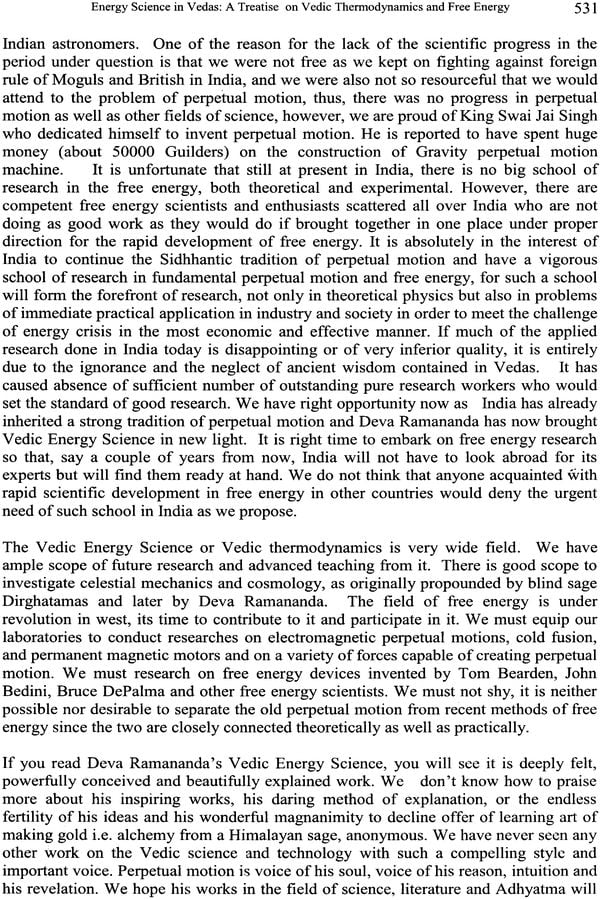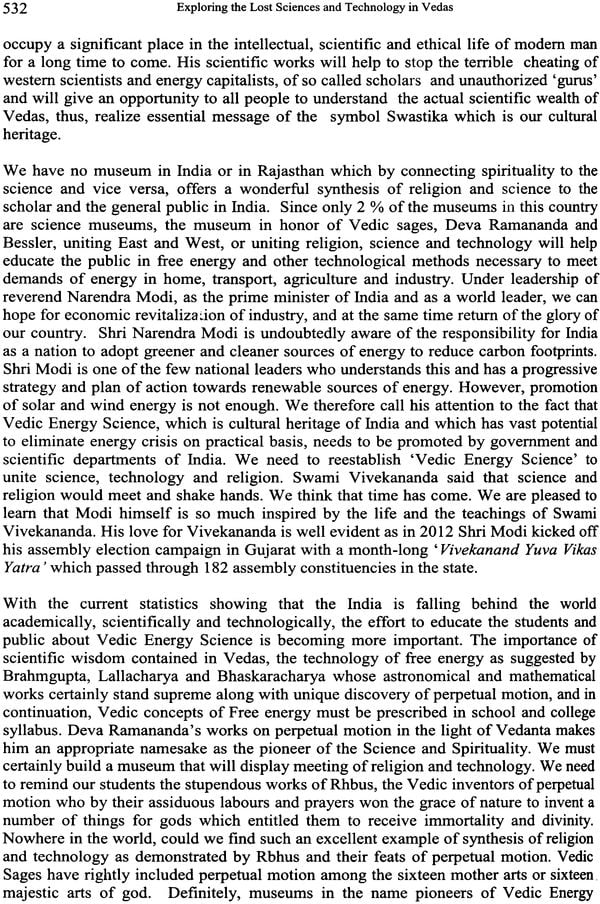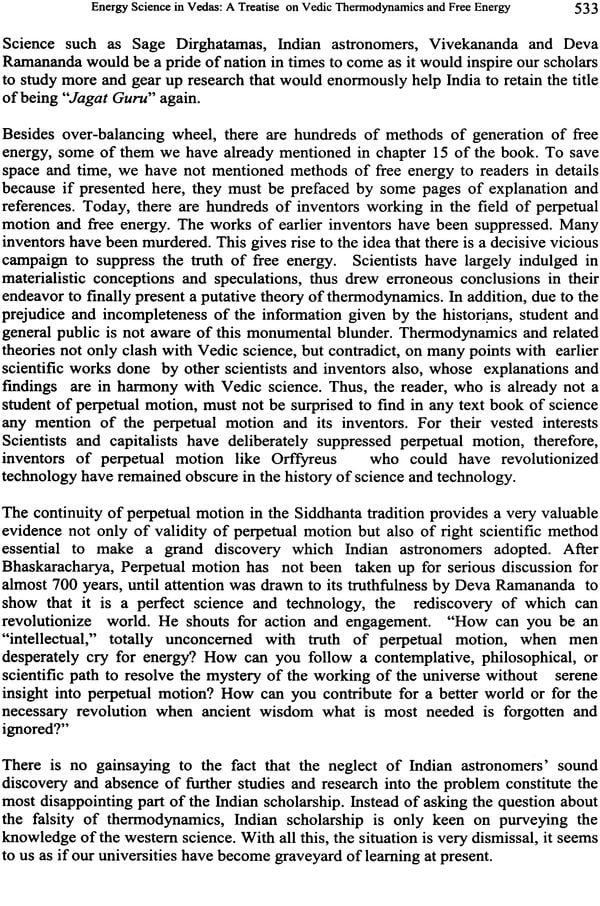
Energy Science in Vedas: A Treatise on Vedic Thermodynamics and Free Energy (Exploring Lost Science and Technology in Vedas)
Book Specification
| Item Code: | NAL469 |
| Author: | Dr. Ramesh Kumar Menaria and Veda Priya |
| Publisher: | Parimal Publication Pvt. Ltd. |
| Language: | English |
| Edition: | 2016 |
| ISBN: | 9788171105564 |
| Pages: | 581 (8 B/W Illustrations) |
| Cover: | Hardcover |
| Other Details | 11.0 inch X 8.5 inch |
| Weight | 1.60 kg |
Book Description
The purpose of this work is to propagate Vedic energy doctrines and related fundamental concepts that led Indian astronomers to the amazing discoveries of zero, infinity and the self driven mercury wheel. Authors have attempted to show that Vedic hymns devoted to a number of powers of nature provide a good opportunity to investigate fundamental principles of energy and their diverse forms like gravity, heat, light, electromagnetic energy and their various manifestation; this has been achieved by exploring attributes, has been achieved by exploring attributes, properties, activities and functions of Vedic gods viz., Agni, India, Surya, Ashvins etc which are actually personification of natural forces sung by Vedic Rishis. Vedic cosmology, Vedic astronomy and Vedic mechanics are based on the principle of cyclical perpetual motion. Hymns devoted to Agni, Nasadiya Sukta and Asyavamsaya hymns have been interpreted in details to show that Vedic energy science stands in flagrant contradiction to classical thermodynamics. According to authors of this book, a critical survey of Vedic hymns show that Self-moving principle is central to Vedic philosophy, mechanics, astronomy and cosmology, a detailed study of which forms the foundations of "Vedic Energy Science." The investigations into "Vedic Energy Science" lead to a holistic worldview which is in contradiction with fragmentary worldview that emerges from the study if thermodynamics. The exploration of "Vedic Energy Science" constitute a radically new frontier of knowledge in the contemporary world, opening out vistas of what it is possible for mankind to know and to realize, which extend far beyond present scientific conceptions, and which urgently demand a revaluation of current paradigms of energy and a re-evaluation of erroneous conceptions, law and theories of science and over all limits of scientific knowledge. Philosophy of action, devotion and salvation has been explored by exemplifying various amazing inventions of Rbhus with special emphasis on self moving Vehicles. In essence energy is one and parallels between Vedic monistic doctrines and modern theories of physics like quantum mechanics, relativity have been drawn.
Vedic God Indra has been extensively investigated to find out various properties of gravity. The relationship between forms and function, structure and expression as regards to gravity and heat leads to conception of Self moving self regulated and self evolved universe. The same principles have been applied to the construction of a self moving gravity wheel that was actually proposed by Indian astronomers and later invented by councillor Orffyreus (1681-2745) in Germany. The story of Orffyreus has been retold to support Self moving principle in new light.
Dr. Ramesh Menaria is currently working as Head, Department of Chemistry, at S.G.G. Government College, Banswara, (Rajasthan). Dr. Ramesh Menarua received his Ph.D. in Inorganic chemistry in 1994 from the Sukhadia University, Udaipur. Dr. Menaria has presented many research papers in national and international conferences in Chemistry as well as Vedic science. In the course of his researches in thermodynamics and later in free energy, Dr Menaria got interested in the study of Vedic concepts related to various forms of energy. He also undertook the scientific study of Rigveda under the guidance of Deva Ramananda. Having been scientifically and spiritually trained in Vedantic tradition, Dr Ramesha Menaria has been engaged in advancing dialogue between religion and science by demonstrating truth of Self-Moving principle described in Vedas for more than last ten years. The book explores the philosophical, scientific, cosmological and astronomical foundations of Energy Science in Vedas that lead to a holistic worldview.
As her name itself shows, Veda Priya has loved Vedas for the beauty of spiritual thoughts contained in them as well as for their scientific contents in all branches if sciences. She is currently working in Finance & Accounts Department, University of Hyderabad. She hold a Master's degree in Public Personnel Management conferred by Osmania University. She has several other certificates and diplomas to her credit. Under the holy guidance and the spiritual practice of her Guru, Himalayan Saint, most reverend Paramahamsa ji and Paramapoojya, Shri Swami Vedananda Saraswathi Maharaj (alias-Veda Babaji), she has enjoyed privilege of bring Associate Editor of the Telugu Monthly Spiritual Mahazine "Om Sai Ram" for nearly two decades. She has contributed several hundreds of articles on various subjects of spiritualism and spiritual life, which were published in "Om Sai Ram" spiritual magazine. Besides, she is trained in Reiki and Kriya Yoga. As a yoga teacher, she has conducted several meditation sessions in India and abroad.
She has deep interest in the mystique of the God's 'Creation' and the similarities of exterior cosmic nature and interior nature of the human beings. In finding answers to countless questions related to the principles of working of the Universe, she started digging deep into the script and transcripts of the Vedas and Upanishads to find out the pearls of Vedic Science and Spirituality. She believes Vedic knowledge is paramount for the material and spiritual perfection of man's life, thus, for benefit of mankind as a whole.
The scientific and intellectual contents of Vedic literature have attracted the attention of some of the world's finest scientific minds, philosophers, renowned poets and historians, namely Erwin Schodinger, Schopenhauer, Einstein, Heisenberg, Aldous Huxley, Carl Sagan, Henry Daid Thoreau, Waldo Emerson, Will Durant and Romian Rolland. Especially, Vedas have also attracted the attention of some of the free energy scientists like Nicola Tesla, in past, and Shri Paramhansa Tiwari, Shri G. Srinivasan and Dr Ramesh Menaria in present times.
According to authors of this book, a critical survey of Vedic hymns show that Self-moving principle is central to Vedic philosophy, mechanics, astronomy and cosmology, a detailed study of which forms the foundations of "Vedic Energy Science." The investigations into "Vedic Energy Science" lead to a holistic worldview which is in contradiction with fragmentary worldview that emerges from the study of thermodynamics. The exploration of "Vedic Energy Science" constitute a radically new frontier of knowledge in the contemporary world, opening out vistas of what it is possible for mankind to know and to realize, which extend far be beyond present scientific conceptions, and which urgently demand a revaluation of current paradigms of energy and a re-evaluation of erroneous conceptions, laws and theories of science and over all limits of scientific knowledge.
Deva Ramananda realized the need for presenting the "Vedic Energy Science" to people so that they can utilize knowledge of Vedic principles to live perfectly harmony with nature. Besides, they can benefit from Vedic principles of energy to fulfil their demands of energy. He strongly believed that the knowledge of Energy Science contained in Vedas helps us to correct blunders prevalent in the theories, laws, and structure of science, especially, laws of thermodynamics which constitutes the foundations of science.
Dr. Ramesha Menaria is currently working as Head, Department of Chemistry, at S.G.G. Government College, Banswara, (Rajasthan). Dr Ramesh Menaria received his Ph.D. in Inorganic chemistry in 1994 from the Sukhadia University, Udaipur. He also undertook the scientific study of Rigveda under the guidance of Deva Ramananda. Having been scientifically and spiritually trained in Vedantic tradition, Dr Ramesh Menaria has been engaged in advancing dialogue between religion and science by demonstrating truth of Self-Moving principle described in Vedas for more than last ten years. The book explores the philosophical, scientific, cosmological foundations of Energy Science in Vedas that lead to a holistic worldview.
As her name itself shows, Veda Priya has loved Vedas for the beauty if spiritual thought contained in them as well as for their scientific contents in all branches of sciences. She is currently working Finance & Accounts Department, University of Hyderabad. She holds a Master's Degree in Public Personnel Managment conferred by Osmania University. She has several other certificates and diplomas to her credit.
Under the holy guidance and the spiritual practice of her Guru, Himalayan Saint, most reverend Paramahamsa ji and Paramapoojya, Shri Swami Vedananda Saraswathi Maharaj (alias-Veda Babaji), she has enjoyed privilege of being Associate Editor of the Telugu Monthly Spiritual Magazine "Om Sai Ram" for nearly two decades. She has contributed several hundreds of articles on various subjects of spiritualism and spiritual life, which were published in "Om Sai Ra,m" spiritual magazine. Besides, she is trained in Reiki and Kriya Yoga. As a yoga teacher, she has conducted several meditation sessions in India and abroad.
She has deep interest in the mystique of the God's 'Creation' and the similarities of exterior cosmic nature an interior nature of the human beings. In finding answers to countless questions related to the principles of working of the Universe, she started digging deep into the scripts and transcripts of the Vedas and Upanishads to find out the pearls of Vedic Science and Spirituality. She believes Vedic knowledge is paramount for the material and spiritual perfection of man's life, thus for benefit of mankind as a whole.
The 'Vedic Energy Science' contains secrets that can change our world. 'Vedic Energy Science' is a work that comes to light at a time when the world deeply needs to read its words. We believe the revival of 'Vedic Energy Science' and further progress in this field will create a free energy revolution. Besides bringing physical advantages to mankind, it will also prove that Western approach to science represents a very narrow range of perceptions; therefore, it leads to fragmentary worldview and dead end. The present book will be of immense help to modern scholars who are eager to understand both material and spiritual knowledge on a scientific basis. We are hopeful that "Vedic Energy science" penned by Dr Ramesh Menaria and Veda Priya will be a source of immense inspiration to all men; it will guide them to live in harmony with nature and enrich lives, both materially and spiritually. The Vedic Energy Science' has power to direct your steps with a new energy and optimism as you head into tomorrow.
Energy is subtle essence and substratum of all the things in the Universe. World has beginning and end in it. Various form of energy are manifestation of Single energy. The rising flood of articles and books published on the subject of energy in the past and present demonstrates it well from philosophical, scientific, technological and an economic standpoints, energy is a central and hot topic! Energy is regarded as life blood of society as it has been our experience that with limited access to energy resources; any society is considerably hindered from industrialization and economic growth. All over the world, energy experts debate about which is the 'best' energy source while taking considerations a large number of factors such as availability and cost of the resource, efficiency of production, public safety, health, and marketing. Policy makers have to tackle with caution these decisions as well as the consequences of the energy source they choose. Besides economic issues, scientists are grappling with environmental concerns about global warming, acid rain, and radioactive waste that influence the energy policies around the world. Never before has mankind been forced to grapple with such an enormous energy and environmental crisis. We have to fully acknowledge the significance and urgency of climate change.
Understanding energy means gaining knowledge about its nature, understanding original resources, their limitations, and the environment consequences of their use. Energy science provides a knowledge base to help understand, predict, and eventually control the natural world and serve as an agent of change in obtaining the vision of a secure and sustainable energy future. The Energy science deals with a variety of forms of energy, corresponding principles and technologies for efficient and clean energy. It also deals with their conversion and utilization, aiming to meet the challenge of rising energy demands and prices, while simultaneously addressing the concomitant environment impact.
The supreme in its importance, the subject of energy is rapidly evolving, however, there are big challenges ahead us, With available scientific knowledge, scientist are working hard to mitigate climate change, secure our long-term energy supply, and provide access to sustainable energy for everyone. They are suggesting us "conservation of energy" by using energy efficient devices, thus, making best use of energy. Due to ignorance of true laws of energy and work, they are not in a position to promise an abundant supply of energy to us and often keep us warning about the looming energy crisis. On the other hand, the main aim of the book is to elucidate the Energy Science contained in Vedas which ensures free production of energy by application of amazing Vedic principles, which in turn prepares us to tackle these challenges easily.
Many reverend scholars in the past have commented on the hymns of Rigveda for the benefit of the mankind. Sublime hymns of Rigveda, revealed to sages thousands years ago, cover a wide field of knowledge, such as cosmology, astronomy physical sciences, biological sciences, social sciences, political science, art and culture, ethics and above all complete Energy Science. The laws of thermodynamics were established in 19th century; therefore, as compared to old ages Vedic thoughts, it is only recently that scientists have come to realize essential unity between various forms of energy and their inter-conversion using various technologies. On the other hand, Sanges who composed a large number of hymns on Agni, Indra Aditi, Ashvins. Marut etc unambiguously expressed their conviction that all the natural forces are in essence one, they believed that there lives 'one spiritual in all things,' and that the whole cognizable world is constituted, and has been developed, in accordance with one common fundamental law. Energy is one in essence. They emphasized by it, in particular, the essential unity of inorganic and organic Various sages observed nature minutely, many questions regarding structure, nature of fundamental forces arose in their minds. They found answers in their meditations that all the wonderful phenomena of nature around us, organic as well as inorganic, are only various products of one and the same original force, various combinations of one and the same primitive matter. We may rightly appreciate that our sages who had unifying conception of nature as a whole were also acquainted well with thorough knowledge of the fundamental scientific and technological principle of energy as well as various forms of energy. We are indebted to Vedic Rishis for their compositions, in which accurate and profound scientific instruction is so often and happily blended with the charms of poetic eloquence. By composing 1028 hymns that describes various properties, functions and interrelationship among the powers of nature, they have enormously contributed towards noble end; that of elevating the aim and enlarging the scope of scientific inquiry regarding true nature of energy and universe.
The monistic philosophy of Vedas, propounded almost five thousands years before our era, had reached speculative heights very remarkable. They found that divinity pervades in all things, a single essence, absolute and infinite binds everything, and nothing is so small that it does not contain a part of the whole, and everything is pervaded by the divine essence whereby it is animated. The knowledge. The knowledge related to pantheism which is predominant in Vedas purports to give information about various forms of energies defied as various kinds of Devas. Hence, their knowledge enable us to understand how the specific characteristics of a particular form of energy lead to individual technologies that can influence their performance considerably when same energy is adopted to perform works for human beings. Thus, to perform domestic works, sages summon Ashvins, which are twin gods associated with solar and other forms of electromagnetic energy. Hymns devoted to Agni, Indra, Ashvins and many other have been interpreted in details for their scientific and their energetic have been described that leads to the formation of Vedic thermodynamics which we find in flagrant contradiction with Classical thermodynamics. Authors strongly believe that the solution of energy crisis and many fundamental questions about the true nature of energy and universe still lies as yet beyond the limits of our scientific knowledge of nature. We need to decipher energy science in Vedas for welfare of human race as only Vedic knowledge can emancipate us from out problems. Easy to read and grasped by layman, the book is research based that the first author has carried over past three decades, finally, the scientific truth revealed in Vedas lead us to arrive at the conclusion that science stands dwarf as compared Vedic science. The main theme of the book is 'Energy Science' in Vedas, and its fundamental principles; we hope knowledge of the will help to end the burning problem of energy crisis.
Among the triumphs of the minds of Vedic sages, the doctrine of perpetual motion, the self-moving principle takes a foremost place. It was propounded by Vedic sage Dirghatamas thousands of years ago, but it appears that knowledge of it remained a secret and eventually, it was lost in mist of time until it was rediscovered again by Indian astronomers in the form of mercury driven self moving wheel. Surya Siddhanta explicitly mentions that secret of self-moving wheel gets lost in every Yuga and again gets recovered by some rare person anointed by god. Thus, in present Kaliyuga, we find that secret of self moving wheel was found by Indian astronomers but was lost. It was again rediscovered by Councilor Orffyreus in 1712 in Germany but was lost again. However, before law of energy was established in mid 19th century, a large number of the attempts to build a perpetual motion machine have resulted into magnificent advances in our knowledge of nature, particularly, in the field of mechanics. As alchemy is considered to be as forerunner of chemistry, different types of perpetual motions can be considered as forerunner of different branches of physics, e.g. science of magnetism developed as a result of many attempts to build a magnetic perpetual motion machine, the laws of mechanics are consequence of large number of attempts to build an over-balancing wheel and thermodynamics arose as a result of studies with ideal steam engine that would work in a close cycle. Unfortunately, scientists have failed to understand perpetual that promises free energy to us. The purpose of our book is to highlight the lost science of perpetual motion, major mathematical contributions of Indian scholars in brief and further to emphasize where neglect has occurred, hence, to elucidate the fact that thermodynamics based on the impossibility of perpetual motion rests on false foundation. Swastika denoting perpetual motion, dynamism, energy and prosperity demonstrates artistic, scientific and philosophical significance of Hinduism. Definitely, the rediscovery of perpetual motion and free energy will open up an immense new territory in the realms of knowledge-a subject in which a series of most crucial problems, previously held to be unsolvable, can be replied in the most astonishing manner.
Some of the highlights of the book are as follows:
1. First time, the book attempts to establish correct principles of energy and work. It directly addresses burning problem of energy crisis which is entirely due to ignorance of man and scientists about true Vedic laws of nature. An attempt has been made to explore the foundations of science and technology of free energy in Vedas with support of hundreds of verses. The book is full of fresh information and new insights that well pave way further for new discoveries and inventions in the field of science and technology.
2. Rigveda is the first book of natural philosophy which describes different powers of nature personified as Devas. The book shows which Deva corresponds to a particular force of nature. In doing so the book attempts to describe in detail the properties of various forces viz. electromagnetic force, nuclear force and force of gravitation etc and reveals new information hitherto unknown to the scientist, exemplifying with support of Vedic verses.
3. First time, the books discloses the mystery of flying aerial vehicles and the self moving chariots and describes principle behind working of them not known to scientists and engineers to date.
4. The books critically examines influence of Vedic knowledge on the scientific and mathematical works of Indian astronomers and show how they discovered zero, infinity, Hindu Arabic numerals, decimal system and mathematics and algebra etc. The book further suggests that perpetual motion machine drive by mercury described by all of them must from the foundation of mechanics and thermodynamics. It is only because of failure of scientists to understand perpetual motion that science has gone into wrong direction to establish laws of thermodynamics that also put restrictions on inventions that can generate free energy. The book explores the origin of various astronomical ideas in Vedas including design wheel and describes diffusion of knowledge from India to Europe.
5. The book provides evidence of Self-moving gravity wheel invented and frequently demonstrated by German inventor Besseler/Councilor Orffyreus (1681-1745) in various tons of Germany, viz. Gera (1712), Draschwitx (1714), Merseberg (1715) and finally, at the Castle of Weissenstein in 1717 before a board of examiners comprised of eminent scientist from all over Europe. The paper raises the most important question: Why hasn't gravity wheel of Bhaskaracharya and Bessler been reinvented to generate unlimited amount of energy? The book shows that nature imposes no limitation on the construction of a Gravity wheel; therefore, the laws of thermodynamics which rest on impossibility of perpetual mostion machine are in error.
6. The book attempts further to examine up to what extent Vedic Monism has influenced the concept of energy and its fundamental laws, how Quantum Mechanics, theory of Relativity, and Unified theory are converging close to Vedic thoughts. At last, book guides to construct a Gravity Wheel to demonstrate truth of free energy with optimism that reinvention of it will clearly demonstrate truth of fundamental concepts of Vedic Monism and other scientific truths contained in Vedas.
7. Energy is everything Energy being the most important subject in Science and Engineering, authors hope that the book on Energy Science in Vedas will benefit students in all departments of science as well as students in arts and humanities. It is hoped it will influence thinking of men in the field of spirituality and religion also.
8. The book discusses about suppression of the Vedic Science, limitations of science and examines the following questions in details:
• Is scientific method adequate to understand the secrets of universe, life and consciousness? • How does Vedas help us to become great inventor and scientists?
• What are the possible forthcoming discoveries and invention from Vedas?
• Is salvation possible making discoveries and inventions?
• How can India retain her status of being Jagat Guru?
9. The Book provides exhaustive bibliography at the end, with notes and more than 575 references gleaned from various sources.
Now is the time to expose blunders of physics and commit to Vedic scientific knowledge once again to guarantee a truly secure and sustainable energy future – future built on foundations of 'Vedic Energy Science' that would certainly ensure a faster economic development and the creation of millions of new jobs for our young generations. First time, the falsity of the laws of thermodynamics which reject free energy and perpetual motion has been exposed with support of hundreds of Vedic verses. Thermodynamics is in fact dagger into the heart of Vedic Science.
Finally, let us apologize in advance for any fallacies and 'non-sequiturs' that may be found by readers, in spite of our true endeavors, simply and impartially, to draw none but legitimate and logical conclusions from the arguments and facts; we have advanced in order to establish Vedic thermodynamics.
Let us carry 'Yajna of Energy' in true of Vedas again. Various types of perpetual motions and their corresponding cyclical patterns founds in nature are well described in Vedas; they must be studied, designed to exacting standards using principles revealed by hymns contained in Vedas. Such research includes: flying aerial vehicles and their engines based on perpetual motion or free energy, transportation by free energy, and use of free energy in home, industry, and agriculture. If you are inquisitive, innovative, entrepreneurial, intellectually resourceful, socially responsible, and if you want to know what is there in Vedas all about energy, its principles, and various forms of energy and get more out of the Vedas that is lost in the transition of times, you are welcome to go through pages of this book. If you are interested to learn to work across disciplinary boundaries to carry out energy research and actively create innovative initiatives that would make the world a significantly better place, then, the present book "The Energy Science in Vedas" would enormously serve your interest and would be of great help. We are you will obliged to our sages for offering us secret knowledge of energy found nowhere else in the world. It is in three highest degree desirable that so true and worthy knowledge of Energy Science contained in Vedas should have more attention, encouragement and research than it has hitherto received, for it is only through a natural union of the Avidya (Material Sciences) and Vidya (Spiritual Science) as taught by Vedas that we can approach a realization of the highest aim – the perfection of life by synthesis of religion and science. Here you invited to enjoy the power of Vedic scientific knowledge!
| Foreword, Preface, Acknowledgements..... | I-XVI | |
| 1 | Energy Science in Rigveda Exploring Foundations of The Lost Sciences And Technology In Vedas, Rigveda: An Overview | 1-18 |
| 2 | Journey of Man From Understandiang of Motion to Perpetual Motion | |
| 2.1 | Introduction | 19 |
| 2.2 | Concept of Self Motion | 20 |
| 2.3 | Concept of Self Motion in Philosophy | 21 |
| 2.4 | Roots of the Law of Conservation of Energy | 23 |
| 2.5 | Transfer of Concepts from Religion to Science | 25 |
| 2.6 | Inspiration from Solar Sysrem | 33 |
| 2.7 | Vedic Perpetual Motion | 35 |
| 2.8 | The Objectives of Science of Perpetual motion and free Energy | 38 |
| 2.9 | The Importance of Signs and Symbols of Perpetual Motion | 42 |
| 2.10 | The Path of Perpetual Motion and free Energy | 44 |
| 2.11 | Some Applications of Free Energy in Rigveda | 45 |
| 2.12 | Perpetual Motion in Medieval Times | 46 |
| 2.13 | Orffyreus / Besler (1681-1745): The Forgotten Inventor of Self-Moving Gravity Wheel | 50 |
| 2.14 | The Rise of Thermodynamics | 55 |
| 2.15 | Our Return to Vedas | 60 |
| 3 | The Age And Arrangement of Vedas | |
| 3.1 | The Age of Vedas | 69 |
| 3.2 | The Framework of Vedas | 72 |
| 3.3 | The Number of Vedas and their Meaning | 73 |
| 3.4 | Arrangement of Rigveda | 75 |
| 3.5 | Hymns of Rigveda | 75 |
| 3.6 | Metre | 76 |
| 3.7 | Various Commentaries on Vedas | 78 |
| 3.8 | Pandit Madhu Sudan Ojha: "Human Store House of Vedic Knowledge" | 83 |
| 3.9 | The Scientific Nature of Sanskrit | 84 |
| 4 | Sage Vs Scientist | |
| 4.1 | Introduction | 88 |
| 4.2 | Osho" Acharya Rajneesh on Science and Aristotelian Logic | 92 |
| 4.3 | Limitations of Scientific Method | 94 |
| 4.4 | What is to be done? Understanding the Vedic Symbolism | 96 |
| 5 | Vedic Natural Philosophy Vedas: The First Book of Natural Philosophy | |
| 5.1 | Isavasyopanishada: Avidya and Vidya | 104 |
| 5.2 | Dayananda's Emphasis on Scientific Content in Vedas | 108 |
| 5.3 | Synthesis of Material and Spiritual | 110 |
| 5.4 | Different Sciences in Rigveda, "The Book of Nature." | 114 |
| 6 | RTA: Ordering And Controlling Principle of Nature | 118-123 |
| 7 | Personification of Natural Forces | |
| 7.1 | Beginning of Religion and Rise of Vedic Religion | 124 |
| 7.2 | Peculiarities of Personification | 125 |
| 7.3 | Original Nature of Forces is Supreme | 126 |
| 7.4 | Henotheism | 128 |
| 8 | Vedic Hymns Not Just Shepherd Songs | 132-136 |
| 9 | What is Prakriti (Nature) | |
| Understanding the Mystery of Nature | ||
| 9.1 | Rise of Nature | 138 |
| 9.2 | Understanding the Flux In Nature | 140 |
| 9.3 | Cyclic Creation and Dissolution | 140 |
| 9.4 | Vastness of Invisible Nature | 145 |
| 10 | The Energetics of Vedic Gods: The Powers of Nature | |
| 10.1 | The Birth of Gods | 149 |
| 10.2 | Classification of Gods | 151 |
| 10.3 | Vedic Gods (Natural forces) are in state of Perpetual Motion | 154 |
| 10.4 | Un-decaying Powers of God | 156 |
| 10.5 | Ever-Increasing Power of Gods | 156 |
| 10.6 | Harmony and Synergy among Gods (Devas) | 157 |
| 10.7 | Principle of Harmony | 159 |
| 10.8 | Harmony of Opposites | 160 |
| 10.9 | Mitravaruna | 162 |
| 11 | The Evolution of Gods (Natural Forces) | |
| 11.1 | Introduction | 165 |
| 11.2 | The Survival of Fittest | 170 |
| 11.3 | Transformation of Rbhus | 171 |
| 11.4 | Nature and Different forms of Agni | 171 |
| 11.5 | Science of Yoga | 172 |
| 11.6 | Devolution of Gods (Natural Forces) | 172 |
| 12 | Understanding Natural Forces | |
| Gravity: Understanding the Indra - the Mightiest God | ||
| 12.1 | Isn't Vedic God 'Indra' and his Attributes, Personification of Natural Force We Call Gravity? | 175 |
| 12.2 | Basic Nature of Gravity In Rigveda | 177 |
| 12.3 | Explaining Earthquakes | 184 |
| 12.4 | Gravity as a Masterial and Mechanical Force | 185 |
| 12.5 | His Intelligent and Spiritual Nature | 185 |
| 12.6 | Bi-Fold Nature of Gravity | 186 |
| 12.7 | Birth of Gravity (Indra) and Making of World | 190 |
| 12.8 | Relationship between Work and Force | 192 |
| 12.9 | Acceleration due to Gravity | 192 |
| 12.1 | Power of Gravity is Inexhaustible | 194 |
| 12.10 | Gravity Cannot Be Shielded | 196 |
| 12.12 | Bending of Sun Light under the Influence of Indra (Gravity) | 197 |
| 12.13 | Gravity is Both Young and Old | 198 |
| 12.14 | Folding and Unfolding of World by Gravity | 201 |
| 12.15 | Plurality of Worlds: Multiverse | 201 |
| 12.16 | Different Forms of Gravity | 202 |
| 12.17 | Learning the Secrets of Gravity | 203 |
| 12.18 | Indra Jal: Net of Gravity | 204 |
| 12.19 | Medical and Biological Implications of Gravity in Vedas | 205 |
| 12.20 | Controlling Morphological Development of Embryo by Gravity | 208 |
| 12.21 | Gravity and Ageing | 209 |
| 12.22 | Conclusions On Gravity | 212 |
| 13 | Sun In Vedas | |
| 13.1 | Surya and Indra i.e. (Sun and Gravity) | 214 |
| 13.2 | The Source of Heat in the Sun | 215 |
| 14 | Ashvins As Electromagnetic Force | |
| 14.1 | Introduction | 220 |
| 14.2 | Ashvins as Personification of Electro-magnetic Force | 223 |
| 14.3 | Ashvins as Twin Particles | 224 |
| 14.4 | Ashvins (Electromagnetic Force) as the Fastest Moving God (Natural Force). | 226 |
| 14.5 | Ashvins and Velocity of Electromagnetic Radiation | 227 |
| 14.6 | Mythology that Indicates Ashvins as Personification of Electromagnetic Energy | 229 |
| 14.7 | Feats of Ashvins in Medical Sciences | 230 |
| 14.8 | Fears of Ashvins in Transportation and War | 233 |
| 14.9 | Science Telegraphy | 233 |
| 14.10 | Feats of Ashvins in Agriculture Engineerin | 235 |
| 14.11 | Ashvins as Remover of Poverty and Harbinger of Prosperity | 237 |
| 14.12 | Savitr in Perpetual Motion | 238 |
| 14.13 | Concusions | 239 |
| 15 | Vedic Thermodynamics | |
| Exploring Physical Principles of Force, Energy And Motion In Vedas & Comparison of Vedic Science of Heat With Classical Thermodynamics with Special Emphasis on Principle of Perpetual Motion | ||
| 15.1 | Introduction | 240 |
| 15.2 | How to Solve the Mystery of Energy? | 241 |
| 15.3 | Foundations of Vedic Energy Science | 245 |
| 16 | Agni And Energy | |
| "Vedic Thermodynamics in Hymns Devoted to Agni" | ||
| 16.1 | Introduction | 265 |
| 16.2 | Nature of Heat (Agni) | 265 |
| 16.3 | Relationship between Heat and Work | 276 |
| 16.4 | The Principle of the Least Action | 278 |
| 16.5 | The Relationship between Heat and Light | 279 |
| 16.6 | Energy and Work | 281 |
| 16.7 | N Nature and Action of Gravity | 286 |
| 16.8 | Gravity as Master Cosmic Force | 288 |
| 16.9 | Energy in One | 291 |
| 17 | Science of Free Energy In The First Verse And The First Hymn of Rigveda | |
| 17.1 | Introduction | 295 |
| 17.2 | The First Richa of Rigveda: Free Energy | 296 |
| 17.3 | G. Srinivasab's Theorem of Free Energy derived from The First Hymn of Rigveda | 299 |
| 17.4 | The Worldview based on Vedic Energy Science | 307 |
| 17.5 | Conclusion: The Development of Thermodynamics Is Long Stride on Wrong Path | 309 |
| 18 | Cosmology In Vedas | |
| Perpetual Motion in "Hymns of Creation of Rigveda" | ||
| 18.1 | Introduction | 314 |
| 18.2 | Purusa Sukta | 316 |
| 18.3 | Hiranyagarbha (The Golden Embryo) | 318 |
| 18.4 | Nasadiya Sukta | 320 |
| 18.5 | Breathing without Air: A kind of Great Tapah | 324 |
| 18.6 | The Myth of Big Bang | 333 |
| 18.7 | Quotes in Praise of Nasadiya Sukta | 339 |
| 18.8 | Aditi (RV 10-72) | 340 |
| 18.9 | Visvakarman: The Architect of Gods | 340 |
| 18.10 | Conclusion | 342 |
| 19 | The 'Wheel of Time' & Concept of 'Time' In Vedas | |
| 19.1 | Introduction | 344 |
| 19.2 | AV XIX, 54: Prayer to Kala (Time) | 345 |
| 19.3 | Brahma's Life Cycle | 347 |
| 19.4 | Duration of Brahma's day | 348 |
| 19.5 | Maha Yuga | 348 |
| 19.6 | Present Manvantara | 349 |
| 19.7 | The 'Wheel' of Time' in West | 350 |
| 19.8 | Pythagoras' Wheel | 352 |
| 19.9 | Concept of Infinity | 354 |
| 20 | Astronomy In Vedas | |
| 20.1 | Original of Astronomy in Veda | 356 |
| 20.2 | The Wheel and Axle Symbolism | 357 |
| 20.3 | Swami Dayananda on Revolution and Rotation of Spheres | 359 |
| 21 | Basic Astronomy Derived From 'Perpetual Motion Celestial Wheels' of Dirghatamas | |
| 2.1 | Introduction | 361 |
| 21.2 | Understanding the Vedic Hymn | 362 |
| 21.3 | Dirghatmas Celestail Wheels: Texts and Translation of Some of Verses | 365 |
| 21.4 | Trinabhi: (Three Axled World) | 367 |
| 21.5 | The Celestial Bodies as Wheels | 373 |
| 21.6 | The Celestial Spheres Make Full Circles | 373 |
| 21.7 | The Celestial Spheres Lie Behind One Another | 373 |
| 21.8 | The Spherical Shape of the Earth and the End of the World | 378 |
| 21.9 | Why the Earth does not fall? | 378 |
| 21.10 | The Mystery of the Seventh Unborn | 380 |
| 21.11 | Dirghatamas' Celestial Time Wheel | 380 |
| 21.12 | Twelve Zodiacs | 380 |
| 21.13 | Energy of Force is one | 381 |
| 21.14 | Conclusion | 382 |
| 22 | The Life of Dirghatamas | |
| 22.1 | Introduction | 384 |
| 22.2 | Dirghatamas' Birth | 384 |
| 22.3 | Dirghatamas' Struggle With Perpetual Motion? | 386 |
| 22.4 | Tripartite World and Three-Fold Nature of Energy | 387 |
| 22.5 | The Three Kind of Creation | 389 |
| 22.6 | Ancestry of Dirghatamas | 389 |
| 23 | Further Development of Astronomy In Vedas | |
| 23.1 | Introduction | 390 |
| 23.2 | Intercalary Month (Adhikmasa) | 393 |
| 23.3 | Twenty-Seven Baharateeya Nakshatra's | 396 |
| 23.4 | Astronomy in Brahmanic Literature | 398 |
| 23.5 | Vedanga Jyotisa | 398 |
| 23.6 | Precession | 401 |
| 23.7 | The Speed of Light | 402 |
| 24 | Katapayadi Sutra | |
| 24.1 | Introduction | 403 |
| 24.2 | Katapayadi Numbers | 404 |
| 24.3 | The Diameter of the Earth | 405 |
| 24.4 | The Velocity of Earth | 405 |
| 24.5 | Value of Acceleration due to Gravity g | 406 |
| 24.6 | Total Area of the Celestial Sphere | 406 |
| 24.7 | Boher Diameter of the Hydrogen Atom | 407 |
| 24.8 | The Diameter of the Proton | 407 |
| 24.9 | Mass of Proton | 407 |
| 25 | Origins of Mechanical Arts In Vedas | |
| 25.1 | Vedic Arts | 409 |
| 25.2 | Evolution of Arts in Vedas | 411 |
| 25.3 | Rbhus and Tvasta | 412 |
| 25.4 | Visvakarma | 412 |
| 25.5 | Purusa | 413 |
| 25.6 | The Sixteen Arts of Gods | 413 |
| 25.7 | Three Splendours and Sixteen Arts | 415 |
| 25.8 | Architecture | 415 |
| 26 | Status of Mechanical Arts In Vedic Society | |
| 26.1 | Introduction | 417 |
| 26.2 | Arts of Agriculture | 417 |
| 26.3 | Military Arts | 418 |
| 26.4 | Arts of Music and Dance | 421 |
| 26.5 | Art of Weaving | 422 |
| 27 | Rbhus - Vedic Inventors And Their Mechanical Feats | |
| 27.1 | Introduction | 425 |
| 27.2 | Aerial Vehicles in Vedas | 429 |
| 27.3 | Ashvins Flying Chariots | 429 |
| 27.4 | Swami Dayananda on "The Art of Building Ships and Aircraft | 430 |
| 27.5 | Rbhus' Self-Moving Chariots | 436 |
| 27.6 | Airplanes and Conveyances in Yajurveda | 438 |
| 28 | Perpetual Motion As Divine Art | |
| 28.1 | Introduction | 442 |
| 28.2 | "One Can Get Salvation by Practice of Mechanical Arts"-Says Vedic Rishi | 444 |
| 28.3 | Philosophy of Action, Devotion and Slvation | 446 |
| 29 | World As Yajna | |
| 29.1 | Introduction | 451 |
| 29.2 | Various meanings of Yajna | 453 |
| 29.3 | Protocols and the Design of Yajna | 455 |
| 29.4 | The Geometry of Altar | 459 |
| 29.5 | Science of Yajna | 461 |
| 29.6 | Science of Yajna and Rain | 463 |
| 29.7 | Science of Sound and Chanting of Sanskrit Mantras | 464 |
| 29.8 | Esults of Some Recent Experiments | 465 |
| 30 | Worship of Nature: Living In Harmony With Nature | |
| 30.1 | Introduction | 467 |
| 30.2 | Western View of Nature | 468 |
| 31 | Forthcoming Inventions And Discoveries From Vedas | |
| 31.1 | Introduction | 473 |
| 31.2 | Immortality, Gravity and Ageing | 475 |
| 31.3 | Reconstruction of Orffyreus' Gravity Wheel | 477 |
| 31.4 | Deva Ramananda on Orffyreus | 477 |
| 31.5 | Vital Data Regarding Working Mechanism | 480 |
| 31.6 | How Does Rigveda help us to invent a Gravity Wheel? | 482 |
| 31.7 | Relationship between Structure and Expression | 483 |
| 31.8 | The Structure of Axle | 487 |
| 31.9 | Yoking the Spheres and Structure of Crossbar | 487 |
| 31.10 | Swastika Based Perpetual Motion Machine | 488 |
| 31.11 | Some Important Hymns on the Nature of Gravity | 490 |
| 31.12 | A Hydraulic Perpetual Motion Machine (RV 10-101) | 491 |
| 31.13 | Discovery of the Communication between Natural forces. Quantum Communication and Teleportation | 493 |
| 13.14 | Layers of Skin | 494 |
| 31.15 | States of Mind | 494 |
| 31.16 | UFO and Artificial Sun | 495 |
| 32 | Monotheism And Monism In Vedas | |
| 32.1 | Introduction | 497 |
| 32.2 | Concept of Monism and its various forms | 498 |
| 32.3 | Some Verse Showing Monotheism | 499 |
| 32.4 | Monism in Vedas | 503 |
| 32.5 | Conclusion | 504 |
| 33 | The Impact of Monistic Doctrines on The Development of Science. | |
| Scientific and Technological Implications of Vedic Monism In A Historical And Futuristic Perspective. | ||
| 33.1 | Introduction | 506 |
| 33.2 | Influence of Vedic Monism on Indian Astronomers and Paradigm of Perpetual motion in Siddhanta School of Astronomy | 508 |
| 33.3 | Diffusion of Vedic Astronomical Ideas in Europe 512 | |
| 33.4 | Western Monism in Science | 514 |
| 33.5 | Laws of thermodynamics | 514 |
| 33.6 | History of Ideas of the 'Unification of Forces' in Physics | 516 |
| 33.7 | Quantum Mechanics | 518 |
| 33.8 | Wave Mechanics | 519 |
| 33.9 | Relativity and Vedanta | 520 |
| 33.10 | Unified Field Theory | 522 |
| 33.11 | Philosophical and Technological Implications of Vedic Monism: Free Energy | 522 |
| 33.12 | Vivekananda, Nicola Tesla and His Dream of Free Energy | 524 |
| 33.13 | Freeing India From Western Shackles of Science: Inspiring Message of Bhagini Vivedita and Dva Ramananda | 529 |
| 34 | Bibliography: References and Notes | 535-557 |
